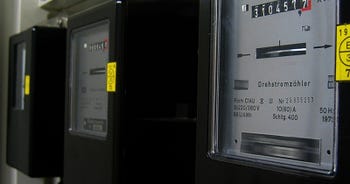What is a carbon footprint and why does it matter to your small business?
In December 2022, less than a third of UK businesses (30%) reported taking no action to reduce their carbon footprint.
This might be an improvement from the year before (46%), but it’s clear not all businesses are proactive when it comes to sustainability and hitting the UK’s net zero target.
As 2050 edges closer, it’s key for UK small business owners to consider their impact of emissions on our planet. Working out the carbon footprint of your business may sound complex, but in this guide we’ve broken down how to go about it and tools to help along the way.
But first, let’s get back to basics.

30 Second Summary:
- UK businesses collectively produced 18.7% of all carbon dioxide emissions in 2022.
- A carbon footprint measures greenhouse gas emissions, primarily carbon dioxide that is emitted from, business activities.
- Emissions are generally categorized into three scopes: Scope 1 (direct emissions), Scope 2 (indirect emissions from energy use), and Scope 3 (other indirect emissions like supply chains).
- Common sources of carbon emissions for businesses include energy consumption, transportation, supply chain activities, industrial processes, and waste management.
- Calculating a business's carbon footprint involves identifying and measuring emissions, often over a 12-month period, and using emission factors to convert measurement data.
- The benefits of reducing a business's carbon footprint include cost savings, enhanced brand image, long-term sustainability, and government incentives and potential investment.
What is a carbon footprint?
A carbon footprint is a measure of the total amount of greenhouse gases, mostly carbon dioxide, that are released into the atmosphere due to the way we live our lives and do business today. Both individuals, businesses and organisations have a carbon footprint.
In the UK it’s estimated that each person emits 13 tonnes of CO2, per year. And in 2022, when looking at UK businesses, they produced 18.7% of all carbon dioxide emissions.
What are the different types of emissions?
As there are different types of emissions, it helps to break them down into three categories:
Scope 1 emissions
This group refers to emissions from direct sources within an organisation. These are emissions from business operations that are owned or controlled. This can be main business activities, such as the burning of oil to power up main factory operations or the petrol emissions from delivery drivers’ cars for a local takeaway.
Scope 2 emissions
These emissions relate to indirect business activities. These could be emissions directly generated from heating and lighting up offices, cafes or restaurants, but only if this is powered by non-renewable energy.
Scope 3 emissions
Scope 3 emissions cover other indirect emissions, normally created by the company’s supply chain, or partners. These are not direct business activities. For example, if you own a fish and chip shop and get all your supplies delivered to your premises in petrol-fueled vans, then the carbon emitted from the burning fuel would fall under this category.
What are indirect carbon emissions?
There are different types of carbon emissions, indirect and direct. indirect CO2 emissions are carbon dioxide emissions that are not directly related to human or main business activities. Instead, they come from secondary business activities, mostly supply chains that support the business - emissions from heating and cooling premises, agriculture, and the production of biofuels from biomass.
Indirect emissions are also caused by activity from suppliers, partners or even employee travel. For example, your business may have indirect emissions from employees driving petrol cars to work every day and from the production of alcohol that you sell in your bar, for example.
What are some common sources of carbon emissions for businesses?
Even though every business is different, many will have similar types of emissions. Whether an organisation is a large enterprise or a micro business with eight employees. Some of the most common include:
- Energy consumption - Every business needs energy to power it. If you have a contract with an existing energy supplier to run your business operations, then you’ll likely be producing carbon emissions as a result. Unless you generate renewable electricity yourself, then the energy you use will come from the UK’s energy mix, this could be oil, gas, biomass, solar or even geothermal energy.
Read all about what powers up your business with our guide to the UK’s energy mix.
- Transportation - No matter your business, transportation that emits carbon is likely to be involved in your operations in some way. This could be your weekly or daily stock deliveries, or depending on the nature of your business, delivery services directly to your customers. Carbon emissions from petrol or diesel cars, vans, and lorries count when calculating your business’s carbon footprint.
- Supply chain - Most businesses have suppliers, whether that's hair products for a salon, chips for a takeaway or alcohol for a pub. These products are normally made in large warehouses or factories and then transported to your premises, emitting carbon along the way.
- Industrial processes - As mentioned above, many products that are sold in UK businesses are manufactured in factories and then stored in warehouses. The processes needed to make most products require fuel, which adds to indirect carbon emissions for your business.
- Waste management - Every business has waste. This could be food waste, agricultural waste, used oil, or basically anything that needs disposal. The process of collecting, and incinerating commercial waste emits carbon.
- Retail and food services - This sector alone contributes 80% more emissions each year than all road transport in the UK, making it a big contributor to greenhouse gases. If your small business falls into this sector, you’ll likely have high energy usage and lots of waste, which both emit high levels of carbon.
How is a carbon footprint measured?
A carbon footprint is the sum of all the direct and indirect emissions a business emits. It’s calculated by summing the scope of emissions from every stage of a product or service’s lifetime - this could be everything from the manufacturing of the products you sell, transportation and waste after unpacking or consumption.
What is the average carbon footprint of a small UK business?
It’s estimated an average UK small business has a carbon footprint of at least 6 percent or 25 millions/tonnes of CO2E. But, these statistics only account for emissions that fall under scope 1 and 2 as only this data is available.
It’s estimated that scope 3 emissions contribute heavily to the total amount, so this makes it difficult to accurately calculate the full extent of emissions for SMEs.
How can we calculate a business's carbon footprint?
If you want to calculate your business’s carbon footprint, you might want to grab a pen and paper, or better yet, make a spreadsheet to tally up your measurements. Follow the process below to get started:
- Determine scope 1 and 2 activities - These are parts of your business you own or have complete control over. If you are a small business and own all your business operations, include everything. If you are a larger business with franchises and partnerships then it gets a bit more complicated. It’s up to you as a business owner to determine which elements of your business you control to include in your total direct emissions. You can use official government guidelines to help with this.
- Identity activities that release carbon - These might include electricity and gas, waste management, recycling, and transportation, for example.
- Measure over a 12-month period - Now it’s time to track your carbon output. You can use a simple spreadsheet to track this and these measurements are predefined, so it doesn’t have to be complicated. See below for how to measure your business activities for carbon output.
| Business activity | Measurement |
| Electricity use | Total kilowatt-hours used from electricity bills |
| Gas use | Total kilowatt-hours used from gas bills |
| Water supply | Total water supplied in cubic metres (m3) from water bills |
| Fuel used in vehicles | Fuel in litres from receipts |
| Employee passenger travel | Receipts for travel, flights and calculate the distance travelled |
| Waste management | Tonnes of waste to landfill and recycled |
If there are activities that are hard to measure or track, use your best estimate. The better your data record, the more accurate the carbon footprint you’ll be able to calculate.
- Convert your data - Calculate your greenhouse gas emissions. There are many ways to do this and it doesn’t need to be manual. The easiest way for busy business owners is to use an online carbon calculator to convert the data. The online tool will work out the amount using an emission factor. This is a coefficient that describes the rate at which an activity releases greenhouse gases into the atmosphere. The calculation is presented in the following formula:
Data x Emission Factor = Greenhouse gas emissions.
You can head to the dedicated SME climate hub for more information on measuring the carbon footprint of your business.
How can businesses reduce their carbon footprint?
- Recycle and reuse - Adapt to sustainable practices in your workplace. This might mean removing all single-use plastic if you are in the hospitality sector or opting for sustainable packaging for your products in retail. All businesses can also make use of waste management systems.
- Invest in renewables - Using traditional fuels will increase your carbon footprint so swapping to renewable options could reduce it and even contribute to your business being carbon-negative. Businesses can install a range of systems such as solar panels, microturbines, biomass and even geothermal heat pumps to replace reliance on gas and oil.
- Use sustainable suppliers - Review your suppliers and swap to those who care about their carbon footprint. There are plenty of suppliers out there like Envopap, who offer sustainable packaging, for example. Or consider sourcing some of your products locally to reduce supply chain and transportation costs. This is also something you could promote in your social media marketing material.
- Consider how you travel - If you travel to and from your premises with a car or van, consider investing in an electric vehicle to cut down on emissions. Encourage your employees to walk, cycle or take public transport to work, you could even offer incentives to encourage this like the Cycle To Work scheme, if your business qualifies.
- Offset your carbon - Invest in initiatives or programs that offset carbon. This means trying to capture the amount of carbon you emit. This could be through local community projects, like community energy, and deforestation funds, for example.
- Monitor Energy Usage - If you have complex operations, then using an energy management system is a great way to monitor, track and optimise your business’s energy usage. You can then make improvements, cut costs and reduce your cargo in the process.
- Educate your company - Update your company policies to include green practices and refresh your employee’s knowledge on recycling, and green modes of transport to encourage them to adopt more sustainable habits at work.
What are the benefits for businesses to reduce their carbon footprint?
Adopting a clear ‘green business strategy’ or just making a few swaps and changes in your workplace all count towards reducing your carbon footprint. But did you know it also has financial benefits? Read on.
Cost savings
Adopting sustainable practices like cutting waste, using energy-efficient practices and recycling, to name a few, can all contribute to cost savings. This means you can save on your energy bills and have lower costs for waste disposal, which is better for your back pocket.
Enhanced brand image
Embracing sustainability and cutting carbon emissions can improve a company’s brand image. In the eyes of the consumer, a business that follows green business practices may be more attractive than one that doesn't, building trust and creating loyal customers. It can also give you a competitive edge and set you apart from competitors.
More attractive to investors
If you’re looking for investment, being mindful of your carbon footprint could make you more attractive. Many investors are increasingly interested in supporting sustainable and socially responsible businesses. If you can demonstrate you are actively trying to reduce the carbon footprint of your business, it may pay off in the boardroom. But be mindful of greenwashing, your efforts should always be genuine. If your business is found to be promoting sustainability without actually demonstrating it, it may hurt your reputation and potential for investment.
Long-term business sustainability
Many business sustainability practices have been driven by new innovations. This will only increase over the next few decades. Those businesses that adopt sustainable practices now, will be prepared for new technology later and ‘futureproofed’ to adapt to new laws and regulations.
Government incentives
Did you know if you go green, you may be eligible for government incentives like small business grants? These are often allocated by local councils, so check the government website for more information. But, you could get a reduced rate on the green taxes all businesses have to pay, including the Climate Change Levy.
How does a carbon footprint affect climate change?
As greenhouse gasses accumulate in the earth’s atmosphere (mostly CO2), The Greenhouse Effect is created. This is where the natural gases in our atmosphere, like carbon dioxide, water vapour, and methane, trap heat from the sun, warming up the planet. This is dangerous because it can lead to an increase in global temperatures that have disastrous effects including:
- Melting Ice - As the earth’s temperature rises, naturally icy areas like Antarctica experience melting ice caps and glaciers, contributing to rising sea levels.
- Extreme Weather Conditions - Rising temperatures can cause intense weather outbursts like hurricanes, floods, wildfires and droughts, which can be devastating for local communities.
- Seasonal Changes - Changes to global temperatures mean seasons shift which can result in Indian summers, and extra rainfall and snowfall unexpectedly.
What is a good carbon footprint to have?
Although there isn’t a set number for a ‘good carbon footprint’, a business that has a low environmental impact and puts sustainable practices in place, is likely to have a low carbon footprint, and low is considered good.
To put this into perspective, if everyone in the UK emits 13 tonnes of carbon per year, then 2.3 tonnes per person, per year tonnes would need to be cut to reach national targets, resulting in 10.7 tonnes, although this reduction is likely higher for businesses.
Switch to a green energy supplier with Bionic
If generating your own renewable business energy isn’t an option, then consider switching to a green energy tariff, where the power you use is generated by renewable sources.
You could even save more by switching to renewable energy.
To compare business energy, pop your postcode in the box on the right or speak to Bertie. Our live chat is available from 9 am to 5 pm, Monday to Friday.








